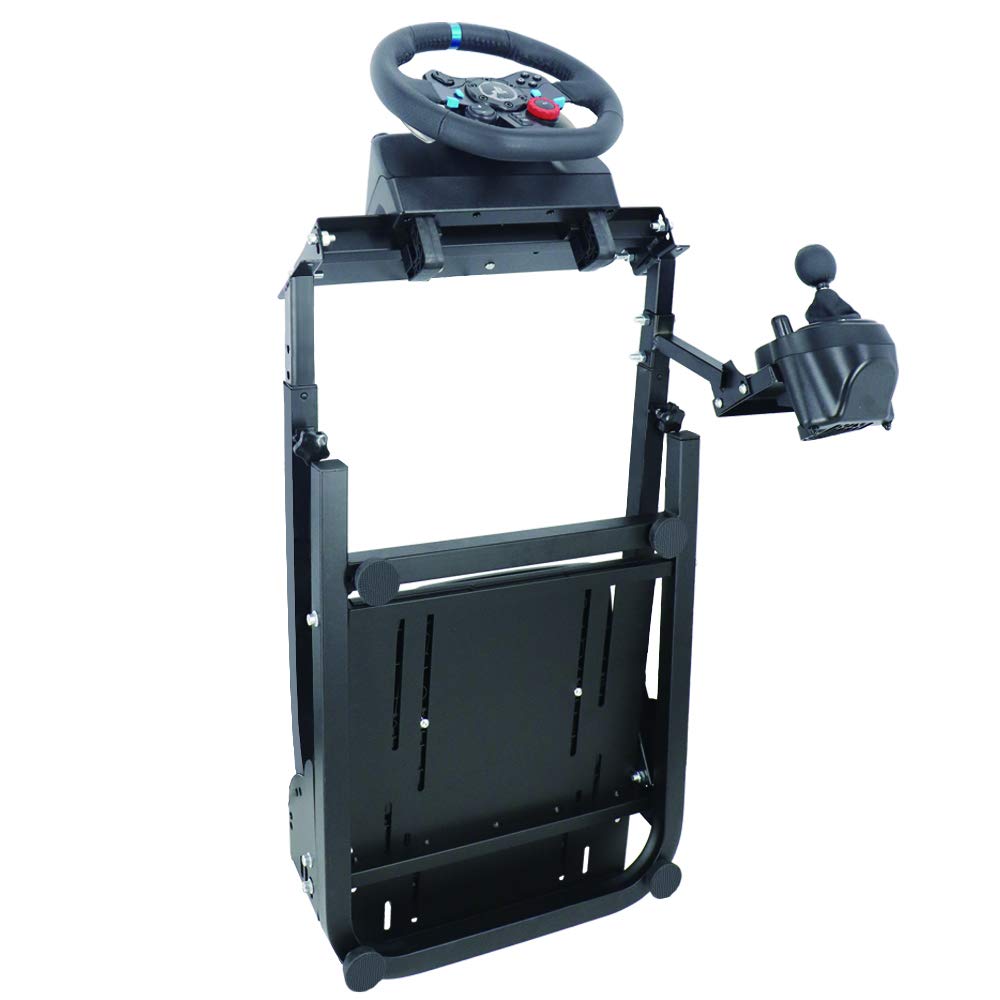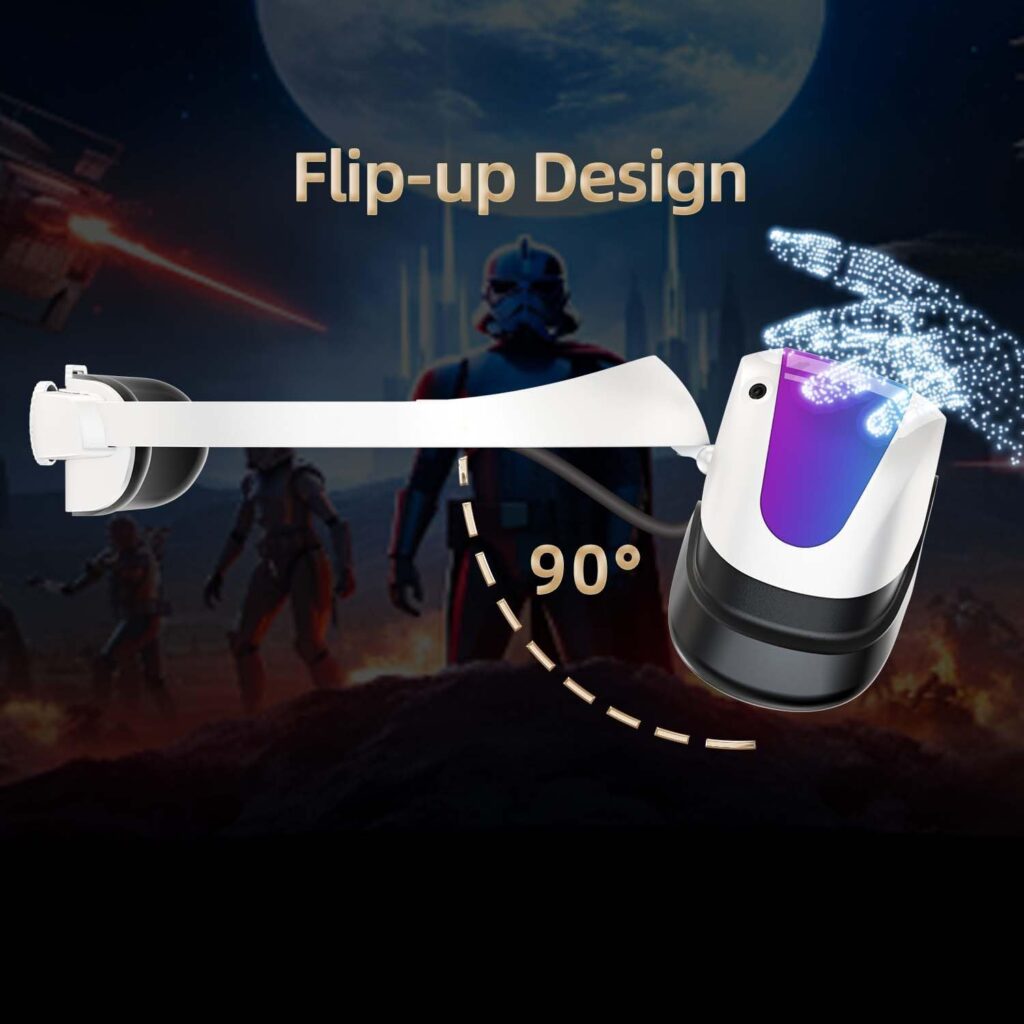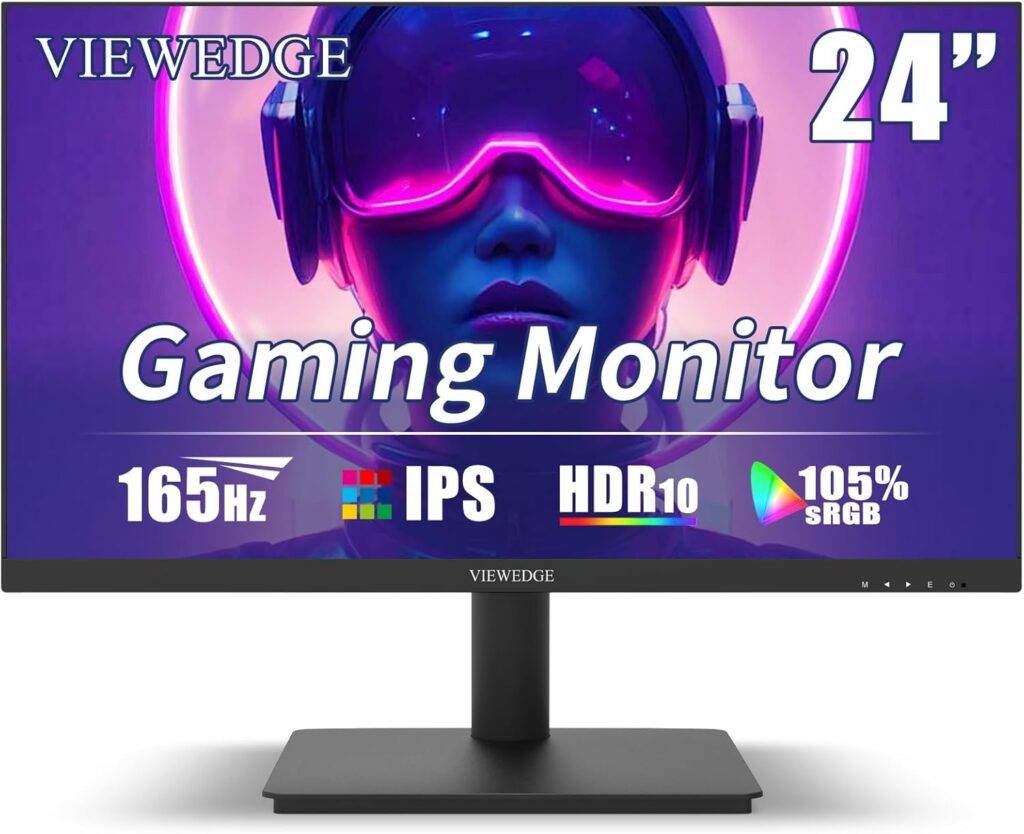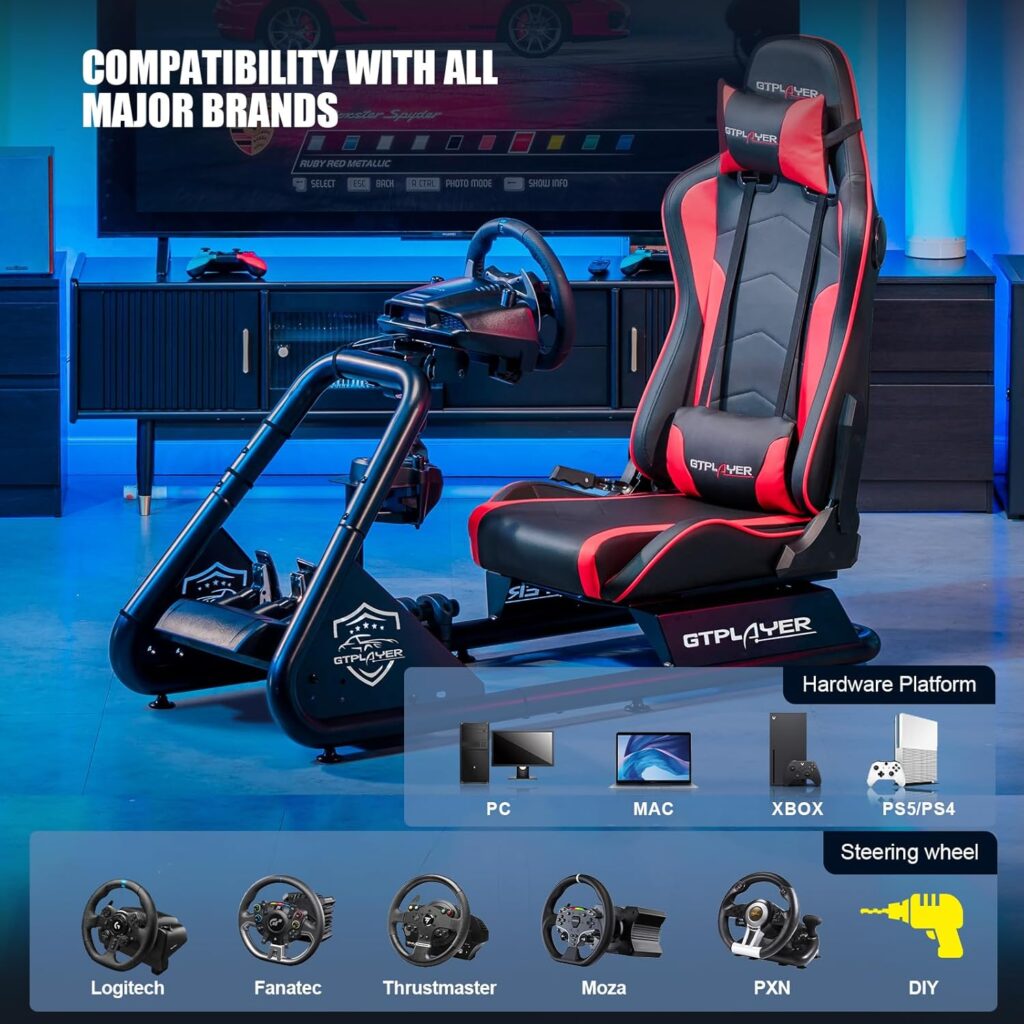So, you've decided to dip your toes into the exhilarating world of sim racing, but you're feeling a bit overwhelmed by the vast array of gear available.
Don't worry, we've got you covered. Imagine being able to feel the rumble of the engine, the precision of every turn, and the adrenaline rush of racing against opponents from around the world, all from the comfort of your own home.
In this beginner's handbook, we'll guide you through the essential gear needed to kickstart your sim racing journey. But buckle up, because it's not just about the wheels and pedals; we'll also explore the world of sim rigs, gaming PCs, and how to create a truly immersive racing experience.
Get ready to take your passion for racing to the next level.
Key Takeaways
- When choosing a sim racing wheel, consider factors such as rotational range, responsiveness, and compatibility with your setup.
- Pedals range from basic to load cell technology, with options like potentiometer-based, hall sensor-based, and hydraulic-based.
- A dedicated sim racing rig with a comfortable and adjustable racing seat is essential for an ergonomic racing position.
- Virtual reality integration can greatly enhance the sim racing experience by providing a more realistic and immersive environment.
Understanding Sim Racing Equipment
To truly immerse yourself in the world of sim racing, it's essential to have a solid understanding of the various equipment that forms the backbone of this thrilling virtual racing experience. In this section of the beginner's handbook, we'll delve into the world of sim racing gear and equip you with the knowledge you need to make informed decisions when building your own sim racing setup.
At the heart of any sim racing setup is the wheel and pedal set. Sim racing wheels come in a variety of shapes and sizes, with different force feedback systems to provide a realistic feel. When choosing a wheel, it's important to consider factors such as rotational range, responsiveness, and compatibility with your chosen racing simulator.
Pedals are another crucial component of a sim racing setup, allowing you to control the throttle, brake, and clutch. While entry-level setups often come with basic pedals, more advanced options feature load cell technology, providing a more realistic and precise braking experience.
Beyond the basics, sim racing enthusiasts can also enhance their setup with additional peripherals such as gear shifters and handbrakes. These add-ons provide an extra layer of immersion, allowing you to replicate the actions of a real racing driver.
In addition to the wheel and pedal set, it's important to consider your screen setup. Many sim racers opt for triple-screen setups or curved monitors to provide a wider field of view. A higher refresh rate is also desirable to ensure smooth visuals.
Lastly, a dedicated sim racing rig provides a stable and ergonomic platform for your equipment. It enables you to adjust the seating position to mimic that of a real race car, further enhancing the immersive experience.
With this understanding of the essential sim racing equipment, you're now ready to embark on your journey into the thrilling world of sim racing. Stay tuned for the next section, where we'll explore the different types of racing simulators and how they can elevate your virtual racing experience.
Choosing the Right Steering Wheel
When selecting the ideal steering wheel for your sim racing setup, it's crucial to consider a range of factors to ensure an immersive and realistic driving experience.
One of the most important factors to consider is the type of force feedback and technology used in the steering wheel. Force feedback provides the tactile feedback necessary to feel the road and make precise adjustments while racing. Look for a steering wheel that offers strong and accurate force feedback to enhance your racing experience.
Compatibility is another key consideration when choosing a steering wheel. Make sure the wheel is compatible with your existing or potential future sim racing setup. Most modern steering wheels are compatible with a variety of platforms, such as PC, PlayStation, and Xbox. Additionally, consider the size, grip, and button layout of the wheel. A comfortable and ergonomic design is essential for long racing sessions.
Adjustability and customization options are also important. Look for a steering wheel that offers adjustable force feedback settings, button mapping options, and the ability to swap out rims. This allows you to tailor the wheel to your specific preferences and needs.
Lastly, do your research and compare different steering wheel options. Read reviews, seek recommendations, and ensure compatibility with your chosen sim racing platform. By considering these factors, you can choose the right steering wheel to complete your sim racing cockpit and elevate your racing experience.
Exploring Different Pedal Options
Different pedal options in sim racing offer varying levels of realism and performance. When exploring different pedal options, it is important to consider factors such as weight limits, progressive resistance, and compatibility with your sim racing setup. Let's take a closer look at the different types of pedal options available to beginners in the world of sim racing:
| Pedal Type | Realism | Performance | Price |
|---|---|---|---|
| Potentiometer-based | Moderate | Average | Affordable |
| Hall sensor-based | High | Above Average | Mid-range |
| Load cell-based | Very High | Excellent | Expensive |
| Hydraulic-based | Extremely High | Outstanding | Premium |
Potentiometer-based and hall sensor-based pedals are suitable for beginners who are just starting out in sim racing. They offer a decent level of realism and performance at an affordable price. However, if you are looking for a more immersive and precise experience, load cell-based pedals are a great option. While they come with a higher price tag, their excellent performance justifies the investment. For those seeking the ultimate in realism, hydraulic-based pedals offer an unparalleled experience. With their outstanding performance, they are the top choice for serious sim racers who prioritize authenticity above all else. Remember, selecting the right pedal option is crucial for enhancing your sim racing experience and taking your skills to the next level.
Selecting the Ideal Racing Seat
Consider the material, adjustability, and comfort of your racing seat to ensure an optimal and enjoyable experience during long racing sessions. A good racing seat is essential for maintaining a stable and comfortable position while racing. Look for a seat that provides firm support and adjustable features to accommodate different body types and preferences. This will allow you to find the perfect position for steering, maximizing your control over the wheel and pedals.
When selecting a racing seat, it's important to prioritize compatibility with your sim rig and other peripherals. Ensuring that the seat fits securely and is compatible with your setup will enhance the overall experience. Look for options with features such as reclining, lumbar support, and durable construction to enhance the immersive experience.
Additionally, consider the material used in the construction of the seat. Opt for a seat made from high-quality materials that aren't only comfortable but also durable. This will ensure that your racing seat stands up to the rigors of long racing sessions.
Enhancing Your Experience With Virtual Reality
To truly immerse yourself in the world of sim racing, there's no better way than enhancing your experience with virtual reality (VR) technology. VR takes sim racing to a whole new level, transporting you into the driver's seat of your favorite race car. By placing you inside the racing environment, VR provides a more realistic and engaging experience. With a VR headset, you get a 360-degree view, enhancing the realism and creating a truly immersive sim racing experience.
When choosing a VR headset for sim racing, there are a few important factors to consider. Firstly, you need to look at the resolution of the headset. Higher resolution means clearer visuals and a more detailed view of the track.
Additionally, the refresh rate of the headset is crucial, as a higher refresh rate reduces motion blur and ensures smoother gameplay. Lastly, the field of view is essential as it determines how much of the racing environment you can see. A wider field of view enhances the sense of immersion.
Adding VR to your sim racing setup can truly elevate your experience. However, it's important to ensure compatibility with your existing sim racing gear, such as your racing wheel, direct drive wheelbase, sim racing pedals, and sim racing rig. Check for software compatibility as well, as not all sim racing games support VR.
To maximize your VR experience, it's crucial to set up your VR system properly. This includes adjusting the headset for comfort, ensuring a secure fit, and properly calibrating the sensors. Taking the time to set up your VR system correctly will help avoid discomfort and ensure optimal performance.
Frequently Asked Questions
What Is the Basic Setup for Sim Racing?
To get started with sim racing, you'll need a basic setup.
Choose a steering wheel that suits your preferences, and consider pedal configurations such as clutch, brake, and accelerator.
Find a comfortable seat and adjust your seating position for optimal control.
Set up a monitor or VR system for immersive visuals.
Adjust the force feedback settings to your liking and map buttons for easy control.
Explore different sim racing software options and join online racing communities for a thrilling experience.
As you progress, upgrading your setup may become necessary, but don't worry, troubleshooting common issues is part of the fun!
Do You Need a Rig for Sim Racing?
Yes, you need a rig for sim racing. A rig is essential as it provides stability and comfort during your races, allowing you to focus on your performance.
There are various types of rigs available, ranging from basic folding frames to advanced motion platforms. Using a rig enhances immersion and improves your overall experience. It also allows for optimal positioning of your equipment, ensuring better control.
Don't worry if you're on a budget, there are alternative options to consider.
Can I Learn to Drive With Sim Racing?
Yes, you can definitely learn to drive with sim racing! The learning curve may be different compared to real driving, but sim racing offers numerous benefits for beginners.
It's a cost-effective alternative to traditional driving lessons and allows you to practice and tweak driving techniques. Sim racing can improve your real-life driving skills by providing a safe and immersive environment.
Just ensure you choose the right simulator software and set up your equipment correctly for optimal learning.
Can You Mix and Match Sim Racing Gear?
Yes, you can mix and match sim racing gear to create your ideal setup. Compatibility concerns should be taken into account when combining different components.
Some of the best brands for sim racing gear include Logitech, Thrustmaster, and Fanatec.
Customizing your setup allows you to prioritize certain components and upgrade your sim racing gear over time.
Consider whether you prefer wireless or wired gear, finding the right wheel and pedal combo, and the importance of a good racing seat.
Finding the right gear for your budget is also crucial.
Sim racing gear can have a significant impact on your performance, so choose wisely.
Conclusion
Congratulations, you have now reached the finish line of 'Sim Racing Gear for Dummies: A Beginner's Handbook.'
Armed with this newfound knowledge, you're ready to dive headfirst into the exhilarating world of sim racing.
With the right equipment, from steering wheels to racing seats, you can create an immersive experience that will leave you breathless.
So strap in, get ready to rev those virtual engines, and prepare for the thrill of a lifetime.
The checkered flag is waiting for you!




